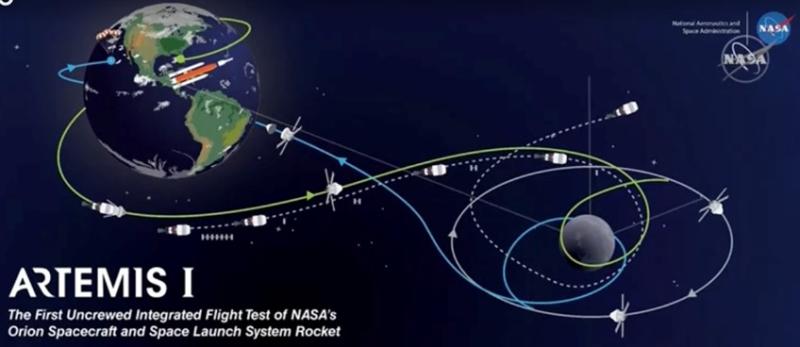The Artemis I uncrewed mission to the moon remains on track to launch from the Kennedy Space Center in Florida on Aug. 29, NASA and European Space Agency officials said in a briefing on Friday.
The mission with the Orion spacecraft and Space Launch System is expected to last 42 days with a splashdown off the coast of San Diego on Oct. 10. Orion will travel from earth a distance of 280,000 miles beyond the moon and pass around the moon before its return, covering a distance of 1.3 million miles.

Primary goals of the test mission include demonstrating Orion’s systems in space and ensuring a safe re-entry, splashdown and recovery prior to Artemis II, which is expected to launch in 2024 with its first human flight crew. Artemis III would then follow in 2025 with annual flight crew missions afterwards, including missions heading to Mars.
Within the broader goals for Artemis I, officials in Houston described via an internet briefing the need to check an Orion heat shield for tolerance to re-entry temperatures that could be half the temperature of the Sun.
Hundreds of sensors are contained in the heat shield, made up of 1,300 silica tiles, to measure the impact of heat, while other sensors are deployed to analyze the weight of the splashdown after 11 parachutes slow the descent from 25,000 miles an hour (Mach 32) to 20 miles an hour once Orion hits the Pacific Ocean.Hundreds of elements of Orion, the Space Launch System rockets and other elements have been rigorously tested on Earth, but re-entry heat shield and splashdown elements are difficult to replicate in laboratories, NASA scientists explained.
As many as 4,000 vendors have contributed parts and main elements to the mission from every U.S. state and many European locations, with ESA providing a service module that rides just behind the crew module. Orion testing lasted 47 days in a NASA thermal vacuum facility in Ohio. Electromagnetic interference testing was done to ensure electronics work properly.
A successful final “wet dress” launch rehearsal was held in June at Kennedy under a full Moon before the SLS and Orion were rolled back to a vehicle assembly building. It be rolled out to Launch Complex 39 about 11 days prior to the scheduled Aug. 29 launch.
The Artemis missions have benefited from science testing aboard the International Space Station and Apollo missions to the Moon with the first landing of astronauts Neil Armstrong and Buzz Aldrin on the surface of the moon July 16, 1969.
NASA plans to land the first woman and first person of color on the Moon with the Artemis missions, but astronauts for Artemis II have not been chosen. Any of 42 astronauts in a current class are eligible for Artemis missions, said Reid Wiseman, chief astronaut. The class ranges in age from late 20s to mid-60s, he said.
Astronauts for the Artemis II mission could be picked in late 2022.
RELATED: Artemis 1 preps for no-crew launch this spring to circle the moon
RELATED: Artemis 1 to carry manikins with thousands of radiation sensors to moon